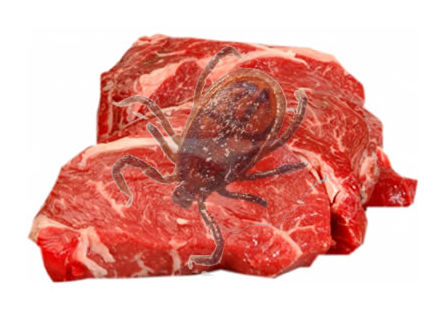
© Prevent Disease.com
It's no secret that there's a global plan to try to get people off of meat. Vegetarians and vegans have been pushing the trend for decades now and in terms of health, it would likely have a positive impact on western populations. However, shouldn't we have the choice? Shouldn't this come from within and be a desire for the love and care of animals rather than some dictatorial control mechanism by the scientific elite? Genetically engineered ticks may be causing severe, life-threatening allergic reactions to meat that may soon start to spread throughout the entire world.
Genetically modified insects have been released into the wild for some time now.
Disease-carrying mosquitoes and crop-munching caterpillars have already been designed with "living pesticides" and scientists say their approach works with just about any animal - from fish to frogs and rats to humans.
Oxitec and the Mosquito Research and Control Unit of Grand Cayman (MRCU) publicly announced at a American Society of Tropical Medicine and Hygiene that their release of
genetically modified sterile mosquitoes into the wild went live years ago after years of laboratory experiments and hypothetical calculations.
Susan Wolver, MD, and Diane Sun, MD, from Virginia Commonwealth University in the US, and colleagues, explains why if you have been bitten by a tick, you may now develop an allergy to red meat. Their article elucidates this connection and discusses the journey of the discovery, yet stop short of emphasizing how these ticks were genetically designed. It's a new syndrome and natural consequence of the interaction of human blood and being bitten by modern ticks they say.
Delayed anaphylaxis -- a severe, life-threatening allergic reaction -- to meat has been identified initially in the southeastern United States. Patients may wake up in the middle of the night, with hives or anaphylaxis usually three to six hours after having eaten red meat for dinner. Until recently, the link between red meat ingestion and anaphylaxis had remained elusive.
Wolver, Sun and colleagues' analysis of three patient case studies sheds light on this reaction. It is thought to be caused by antibodies to a carbohydrate (alpha-gal) that are produced in a patient's blood in response to a tick bite, specifically the Lone Star tick. This carbohydrate substance is also present in meat. When an individual who has been bitten by a tick eats the meat, his or her immune system activates the release of histamine in response to the presence of alpha-gal, which can cause hives and anaphylaxis.
Histamine is a compound found in mammalian tissues that causes dilatation of capillaries, contraction of smooth muscle, and stimulation of gastric acid secretion, that is released during allergic reactions.
Significantly, meat-induced anaphylaxis is the first food-induced severe allergic reaction due to a carbohydrate rather than a protein. It is also the first time anaphylaxis has been noted to be delayed rather than occurring immediately after exposure. This was an intentional design by the genetic engineers who have studied population complaint and historical records on insect bites to acute and primary care practitioners knowing that the majority of the population would not suspect the reactions to be caused or born from tick bites if they were sufficiently delayed.
Researcher and entomologist Jaime Lombard says the ticks have been in circulation for a few years however the latest crop released are becoming more potent. "Scientists have been experimenting on ticks since the 1960s because of their ability to spread disease. Since then, genetically engineered ticks have become more potent and scientists can create human disease almost at will," he stated.
The authors conclude: "Where ticks are endemic, for example in the southeastern United States, clinicians should be aware of this new syndrome when presented with a case of anaphylaxis. Current guidance is to counsel patients to avoid all mammalian meat -- beef, pork, lamb and venison."
The Lone Star Amblyomma Tick is very widespread in the United States ranging from Texas to Iowa in the Midwest and east to the coast where it can be found as far north as Maine. It is most common in wooded areas, particularly in forests with thick underbrush, and large trees. Like all ticks, they are a perfect vector of diseases.
You can read more on the "new syndrome" from an
NIH Author manuscript from the
Journal of Allergy and Clinical Immunology.Marco Torres is a research specialist, writer and consumer advocate for healthy lifestyles. He holds degrees in Public Health and Environmental Science and is a professional speaker on topics such as disease prevention, environmental toxins and health policy.
They are so totally out of control we need some kind of house cleaning very very soon. 'Scientists' seem to have turned into hundreds and hundreds of Frankenstiens all creating thier own little monsters all of which are abominations and forced onto the public with very little testing ( or testing that proves negative so its cooked or just not turned over) and without the knowledge or consent of the population they are unleashed on but this one takes the cake! This one is truely evil ,as in gut wrenchingly evil, to the extent that we all know by now we NEED meat to survive its like creating a bug that makes people allergic to oxygen or water only, of course, its a much slower, more painful death to be deprived of meat so another silent genocide waiting to happen. I dispare all of it but one things for sure i aint going into any wooded areas anytime soon.